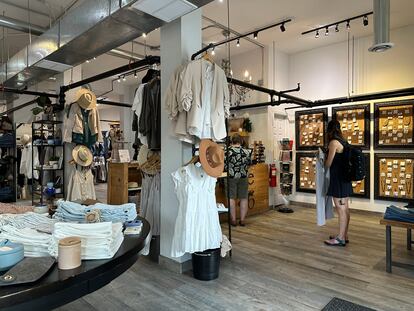Retail sales rise 0.6% in August largely due to a spike in gas prices
The big rise in gas prices accounted for more than half of the inflation increase recorded in August

Americans stepped up retail spending modestly from July to August as the price of gasoline jumped, cutting into budgets as many families send their kids off to school.
Retail sales rose 0.6% in August, compared with a revised 0.5% increase in July, according to a report issued by the Commerce Department on Thursday.
A closely watched category of retail sales that excludes auto dealers, gas stations and building materials and feeds into the gross domestic product increased just 0.1% last month compared to the prior month, after a revised 0.7% increase in July.
The big rise in gas prices accounted for more than half of the inflation increase recorded in August, the U.S. Labor Department reported Wednesday. The surge in gas prices is coursing through the economy and could slow down shoppers’ momentum heading into the critical holiday shopping season.
In fact, U.S. wholesale prices — which measures inflation before it hits consumers — accelerated in August, largely because of higher gas prices, according to a report issued by the Labor Department. That’s a sign that inflation remains stubbornly persistent despite a series of sharp interest rate hikes by the Federal Reserve.
The national average price for a gallon of unleaded gasoline last week reached $3.86 as of Thursday, 5 cents more than the week prior, AAA said.
Excluding gas sales’', retail sales were just up 0.2% for August, according to the Commerce Department report.
Sales at gas stations rose a robust 5.2%, while furniture and home furnishings stores saw a 1% drop in sales. Clothing and accessories stores and electronics store registered sales increases, likely helped by back-to-school spending. Online sales were unchanged in August, perhaps hurt by robust spending during the Amazon Prime day sales event in July.
The retail report covers only about a third of overall consumer spending and doesn’t include services such as haircuts, hotel stays and plane tickets. But it does capture spending at restaurants, which had a slight uptick last month.
The figures are not adjusted for inflation unlike many other government reports.
August’s uptick in retail sales, which marks the fifth straight monthly gain, reflects the economy’s resiliency despite a still tough economic environment. Yet spending has been volatile this year after surging nearly 3% in January. Sales tumbled in February and March before recovering in the spring and summer.
The most recent quarterly financial reports from retailers like Macy’s and Target showed that Americans remain cautious as higher interest rates make cars, homes or using credit cards more expensive. In fact, some retailers cited a pick up in credit card delinquencies. And many retailers flagged the end of the student loan moratorium, which had provided one-time college students a little more financial breathing room.
“It is hard to see consumers spending as freely over the rest of the year,” said Michael Pearce, lead U.S. Economist at Oxford Economics, in a note published Thursday. “We expect a sharp slowdown in consumption growth, which will be the decisive factor tipping the economy into a mild recession over the coming quarters.”
Inflation jumped last month largely because of the spike in gas prices but other costs rose more slowly, suggesting price pressures are easing at a gradual pace.
In a set of conflicting data released Wednesday, the Labor Department said the consumer price index r ose 3.7% in August fr om a year ago, up from a 3.2% annual pace in July. Yet excluding the volatile food and energy categories, so-called core prices rose 4.3%, a step back from 4.7% in July and the smallest gain in nearly two years. That is still far from the Federal Reserve’s 2% target.
America’s employers added 187,000 jobs in August, evidence of a slowing but still-resilient labor market despite the high interest rates the Federal Reserve has imposed.
In the latest sign that companies are not feeling pressure to increase wages, Walmart is cutting starting pay for some of its new hourly workers like those picking online orders at its stores. The change became effective in July and will create consistency in starting hourly pay across individual stores, said spokeswoman Anne Hatfield, as well as improved staffing and customer service.
Given this uncertainty, many retailers are being cautious about ordering products from toys to clothing for the holiday shopping season.
They’re also hoping to lure shoppers in with new partnerships that will draw them into the store. Target, hurt by cautious consumer and a backlash to its Pride merchandise, announced earlier this week a deal with jewelry brand Kendra Scott. Prices for the more than 200 new exclusive pieces that include necklaces, rings and accessories will range from $15 to $60. The collection will be available in select stores next month.
Sign up for our weekly newsletter to get more English-language news coverage from EL PAÍS USA Edition
Tu suscripción se está usando en otro dispositivo
¿Quieres añadir otro usuario a tu suscripción?
Si continúas leyendo en este dispositivo, no se podrá leer en el otro.
FlechaTu suscripción se está usando en otro dispositivo y solo puedes acceder a EL PAÍS desde un dispositivo a la vez.
Si quieres compartir tu cuenta, cambia tu suscripción a la modalidad Premium, así podrás añadir otro usuario. Cada uno accederá con su propia cuenta de email, lo que os permitirá personalizar vuestra experiencia en EL PAÍS.
¿Tienes una suscripción de empresa? Accede aquí para contratar más cuentas.
En el caso de no saber quién está usando tu cuenta, te recomendamos cambiar tu contraseña aquí.
Si decides continuar compartiendo tu cuenta, este mensaje se mostrará en tu dispositivo y en el de la otra persona que está usando tu cuenta de forma indefinida, afectando a tu experiencia de lectura. Puedes consultar aquí los términos y condiciones de la suscripción digital.
More information
Últimas noticias
ChatGPT fails the test: This is how it endangers the lives of minors
The late consecration of women artists in their 90s
The Florida Keys tourist paradise is besieged by immigration agents: ‘We’ve never seen anything like this’
The latest scam on WhatsApp behind the legal dream: using immigration status as bait
Most viewed
- Families demand repatriation of bodies of Colombians who died in Ukraine: ‘This war is a slaughterhouse for foreigners’
- The low-cost creative revolution: How technology is making art accessible to everyone
- Liset Menéndez de la Prida, neuroscientist: ‘It’s not normal to constantly seek pleasure; it’s important to be bored, to be calm’
- Christian Louboutin: ‘Young people don’t want to be like their parents. And if their parents wear sneakers, they’re going to look for something else’
- ‘El Limones’ and the growing union disguise of Mexican organized crime










































